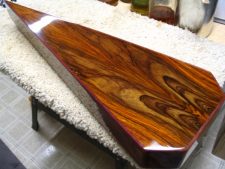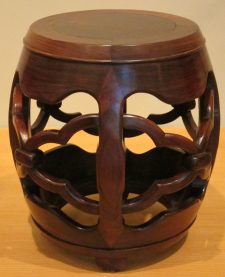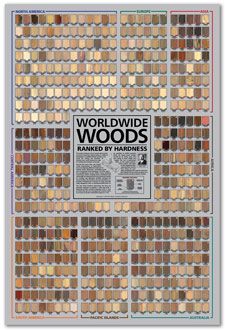So there seems to be a lot of hub-bub arising recently over the news that rosewoods (as well as Bubinga) are now banned. But is this actually the case? And if so, what does it mean? What is “banned” and what is still allowed?
THE SHORT ANSWER IS YES.
If you take a look at the updated CITES appendices (as updated and effective January 2, 2017), you will see a new listing that shows “Dalbergia spp.” as well as the three Guibourtia species that are more commonly known as Bubinga, are all listed under Appendix II.
It’s important to note that this “Dalbergia spp.”—though perhaps appearing somewhat innocuous in its Latin botanical naming—denotes the powerhouse genus that contains all true “rosewoods” in the most proper sense of the word (think of such stars as Brazilian Rosewood, East Indian Rosewood, or Honduran Rosewood, just to name a few). This genus also contains a number of other stellar hardwoods that are very similar (and of course closely related) to rosewoods, but lack the actual “rosewood” title in their common name. This includes woods like Cocobolo, Tulipwood, Kingwood, and African Blackwood, just to name a few.
WHAT IN THE WORLD IS GOING ON HERE?
First off, some clarifications are needed.
What is meant by “banned”? This does not mean that it is somehow illegal to simply own rosewood, or work with rosewood, or even to sell rosewood or the things that you have made out of rosewood. If you are a woodworker, and you have some Bubinga or rosewood, you should be fine (or, at the very least, what went into effect at the beginning of 2017 does not have any bearing on your immediate situation.) Unless you are doing some serious stuff (i.e., Gibson guitar), you probably won’t need to worry about any kind of special investigators coming around knocking on your door asking to see your stash of lumber.
So what does this new development mean?
It all starts with an organization called CITES, which stands for Convention on International Trade in Endangered Species. The keyword here is international trade. This new development has impact only for wood that is crossing international borders. If you’ve got wood in your shop, you’re cool—nothing to worry about. But before you write this latest development off as nothing of note, you should consider that most of the exotic wood that woodworkers use comes from other countries—and must by necessity cross international borders. So how is it going to get to you? Where are you going to continue getting that wood? That’s where things get interesting.
A QUICK PRIMER ON CITES
In a nutshell, CITES keeps what might be thought of as a list of endangered species whose trade is regulated or restricted in some way. While there might be other environmental watchdog groups or organizations that would report a tree/wood as being threatened with extinction (such as the IUCN), their reports or observations are more or less just that: observations. They are in no way legally binding. CITES is different. When CITES passes a resolution, it more or less becomes international law (at least in one sense of the word). Thus, it behooves woodworkers and others in the lumber industry to pay special attention to what is going on with CITES, and to have a working knowledge of the ramifications.
The CITES list is divided up into three different tiers, which they called appendices.
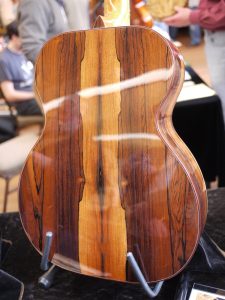
Photo by Moses Gunesch / CC BY
- Appendix I is the most restrictive category, and includes species that they consider to be threatened with extinction. Probably the best woodworking example of this is Brazilian Rosewood (Dalbergia nigra)—which also includes finished products made of the wood. (Perhaps you may have heard of horror stories of people having their guitars confiscated/forfeited when trying to travel internationally with them.)
- The next tier is appendix II, and basically is described as covering vulnerable species that are at risk and in need of protection to prevent them escalating to appendix I status in the future.
- Appendix III is the least restrictive, and is usually only added for a specific source country to help aid in the enforcement of restricting trade in an international setting.
CITES includes representatives from just about every country in the entire world, and each country/representative is referred to as a “party.” Every three years or so, all the parties meet together in what is known as a “convention of the parties,” or a CoP for short. During this time, the parties will potentially re-evaluate current listings (if a species is recovering and no longer needs legal protection), as well as consider a number of new proposals for species that could potentially be added to the list and receive international protection.
WHAT HAPPENED THIS FALL IN JOHANNESBURG
From Sept. 24 to Oct. 5, 2016, the convention of the parties number seventeen (CoP 17) was held in Johannesburg, South Africa, and the decisions of this meeting have created quite a stir among the woodworking community. Among other things, there were three main wood types that received protection (restriction) under CITES appendix II. They are, listed in increasing order of prominence, as follows:
Kosso (Pterocarpus erinaceus) This hardwood isn’t commonly seen in North America, but is a Pterocarpus species related to the more commonly seen African Padauk. Appearance-wise, it bears a very close resemblance to the related hardwood Muninga. It’s sometimes referred to as African rosewood, though it’s technically not what would be considered a true rosewood (which, strictly speaking, is comprised only of species in the Dalbergia genus).
Bubinga (Guibourtia demeusei, G. pellegriniana, and G. tessmannii) A much loved hardwood, perhaps among the most popular of African imports alongside species like Zebrawood and African Mahogany. In addition to its close resemblance to true rosewoods, Bubinga is also seen with a wide variety of figured grain patterns, and is sold in a wide variety of forms ranging from guitar backs to giant tabletop slabs.
True rosewoods and related species (Dalbergia spp.) While Bubinga could very well be considered every bit as popular as any rosewood, part of the weight of this listing is in its breadth. This includes all true rosewoods, worldwide, as well as a host of other venerable hardwoods found in the Dalbergia genus, such as Cocobolo, Tulipwood, Kingwood, African Blackwood, etc.
On that last point, it might seem curious to protect the entire genus, especially since there are a number of Dalbergia species out there that even the IUCN redlist classifies as being of “least concern”—Dalbergia arbutifolia, D. assamica, D.calycina, and D. cana, just to start naming a few. If this is the case, why add the entire genus to the appendices? Why such an extreme measure?
ONE WORD EXPLAINS IT ALL
At the risk of oversimplifying the problem, to boil it down to a single word to explain it all would be this: CHINA.
I’m not saying that there are a lot of other countries in the world, the United States included, that may use more than their fair share of rosewoods. But in this instance, what might be considered the “extreme” move of including the entire Dalbergia genus on the CITES appendix II, it is primarily due to what is happening in China.
While I don’t claim to even come close to having a full understanding of the culture and traditions of China, I think I have enough information to at least give a general idea of what’s happening. Long story short, Chinese people have a high regard for rosewood, and enjoy rosewood furniture. It’s part of their culture and tradition, and the wood is referred to as hongmu— which I believe literally translates as “red wood,” but is probably more accurately referred to as “rosewood.”
This “hongmu” is so highly regarded, China even has a document of standards that refers to what species are to be formally recognized as hongmu (publication no. GB/T 18107-2000). According to this document, hongmu is divided into 8 different categories, and (at the moment) includes a total of 33 species. (The list is likely to be revised and updated as new hongmu species are sought out.)
Looking at the above list, the most highly regarded timbers are found in categories A and C (Zitan and Huanghuali, respectively). These woods are native to areas in or near China. However, many of the woods in the secondary categories are found in Africa and Central America—suggesting that as supplies of locally-source hongmu become increasingly scarce, there is a ripple effect seen on these second-tier woods.
Referring to the actual CITES proposal that was responsible for the listing of the Dalbergia genus, the document had this to say:
Illegal logging is a prevalent problem in Central America. For instance, it was estimated in 2003 that up to 85% of the total harvest in broadleaf forests in Honduras was illegal. There is very little information on the volume of international trade although cocobolo wood is available from numerous sources online (Jenkins et al., 2012). Extensive illegal trade in rosewoods has been reported, raising concerns that it has accelerated in recent years (Jenkins et al., 2012). Seizures of illegally trafficked timber in Guatemala suggest that there is an organized smuggling ring capable of exporting large quantities. The demand for D. retusa from the Darien Region of Panama has been described as “out of control” with “hundreds of settlers looting” the species (Jenkins et al., 2012).
During the period 2011-2014, 38 shipments and vehicles, with a total amount of 906,244 m3 of Dalbergia timber (mainly trunks, flitches and tables) of D. stevensonii, D. retusa and Dalbergia spp. (reported as rosul) of illegal origin were confiscated in Guatemala (almost two times the CITES timber reported as legally exported for the same period). With the exception of two shipments destined to Honduras and El Salvador, all the other shipments were destined to Asia.
SOMETHING BIG IS HAPPENING
So here’s the problem: Chinese rosewood furniture is all the rage at the moment. (Maybe it’s always been popular in China, but as of right now, there are starting to be a whole lot more people that can actually afford this type of furniture.)
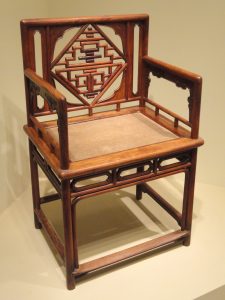
So with over 1.3 billion people in China, and a growing percentage of middle class residents showing interest in rosewood furniture, this is an unprecedented demand. Perhaps there have been trends and fads with a higher percentage of a nation’s populace interested a certain type of wood or woodworking style, when you do the math on the sheer number of people that are showing interest in rosewood, this type of spike in demand is, to my knowledge, without rival.
So what happens when demand goes way, way up? For one thing, prices for the wood follow suit—especially as supplies dwindle. And with prices going up, people are going to be looking for all sorts of ways to get rosewood into China. With this level of money changing hands, with this level of demand, bad things are bound to happen, especially among poorer third-world countries where some of these rosewoods are naturally found.
The CITES proposal had this to say:
Hongmu trade is also linked to and drives violence in source and transit countries. In West Africa, Hongmu species are known as “blood timbers” due to connections between illegal Hongmu trade and rebel group uprisings; for example, in the Senegalese Casamance, in Côte d’Ivoire and in northern Nigeria in territories controlled by the Muslim extremist group Boko Haram. In Thailand, more than 150 forest rangers, police, soldiers and illegal loggers have been killed in gunfights during rosewood enforcement operations in recent years (EIA, 2016).
It’s quite sad that things have to come to such a point that people are dying over logs of wood. Hopefully you can see why CITES and the international community in general needed to do something. Whether or not it was the right thing, or whether it will have a measurable impact on the issue remains to be seen. But surely you can understand why some type of action was taken.
CHINESE KNOCKOFFS—NOW INCLUDING “ROSEWOOD”
So why restrict the entire Dalbergia genus, even when there are a number of species that are (according to the IUCN) clearly not endangered or even at risk for exploitation? I believe the answer is twofold.
First, given the great price of the primary rosewood species driving demand in China, knockoffs and substitutes are being sought out. This is especially true as supplies of these original timbers dwindle, necessitating the hunt for second and third tier species.
But this is also a two-way street. In addition to finding new substitute species and attempting to pass them off as the real thing, it also becomes a loophole where merchants can intentionally misidentify a (legally protected) top-tier species as a lesser (unprotected) species—thus circumventing any protective measures currently in place. The CITES proposal states:
Species shifting, as species become commercially extinct, is a common practice. For instance, with the commercial extinction of D. odorifera in China and Pterocarpus santalinus in India, the trade in D. cochinchinensis grew rapidly and it became the most sought-after Hongmu species globally (EIA, 2016). As D. cochinchinensis was overexploited the main species now dominating the Hongmu trade in South-East Asia are D. oliveri, D. bariensis, Pterocarpus macrocarpus, and P. pedatus (EIA, 2016). In 2014, an estimated 229,796 m3 of D. oliveri logs were traded internationally (EIA, 2016). More and more species of Dalbergia are entering the trade worldwide as stocks of once abundant species are being depleted.
Traffickers exploit any legal loophole to smuggle illegal timber. Traffickers have repeatedly taken advantage of the current gaps in the CITES listings, misdeclaring Dalbergia retusa as the unregulated and similar-looking Dalbergia bariensis in violation of national moratoriums and CITES listings (EIA, 2016). In Guatemala, the documents accompanying rosewood shipments often recorded the export as recycling material (such as cardboard, junk or scrap metal) or other timber species, such as Cupressus, Dialium and Miroxylum. In Mexico, D. granadillo logs are mixed with other species in ship containers to disguise the shipments from authorities since there are no permits to log this protected species (PROCESO, 2014).
WHERE BUBINGA COMES INTO PLAY
A side note is that a couple of other wood types were also listed in the CITES appendix II along with rosewoods: Kosso and Bubinga. Both restrictions come almost entirely as the result of the situation in China. The CITES proposal dealing with Bubinga (listed just after the Dalbergia proposal) had this to say:
The woods of the different Bubinga species, the aesthetic qualities of which are close to those of the Asian rosewood species which are most highly prized in the Hongmu tradition, have gradually become established as the first choice alternative for this burgeoning sector. In the course of the past five years, the expansion of this “Hongmu demand” for the supply of the Chinese markets has led to unprecedented interest in Bubinga in the main producing countries of its range, particularly in Gabon and Cameroon.
So what was the fault in that Bubinga was so stringently restricted? Simply put, it looked too much like rosewood. And going right along with this, Kosso has met a similar fate. Although this species isn’t seen very often in North America, the CITES proposal commented “Available information suggest that Pterocarpus erinaceus was in 2015 the most traded species of ‘Hongmu,’ in volume, at the international level.”
DIFFICULT WOOD TO IDENTIFY
Besides the matter of using lookalikes and substitutes, there’s also the very practical issue of reliable wood identification. If you’ve read my article on the truth behind wood identification, you’d know that reliably identifying a wood sample down to the species level is no easy task, and is in fact, short of DNA testing, at times impossible. This is not necessarily the fault of the wood anatomist or customs agent that is tasked with identifying the wood—it is inherent in the wood itself. At times, there are simply not enough unique and exclusive features present in a wood species to differentiate it from another related species. The Dalbergia genus, although chock-full of many highly unique and fabulous species, is still no exception to this identification conundrum.
The CITES proposal makes the following comment about Dalbergia species: “distinction between and identification of individual species is very difficult for non-professionals and sometimes even for experts, making it a problem for enforcement and customs officers to comply correctly with inspection and identification of CITES listed Dalbergia tree and product shipments.” Bear in mind that those writing and weighing in on this issue are some of the most knowledgeable experts in the world when it comes to wood anatomy, and even among this community, they have deemed proper identification to be “very difficult . . . sometimes even for experts”! We are talking about boiling/chemically treating a wood specimen, taking a razor thin slice of the wood, and examining the wood’s structure under a microscope. (This should hopefully be enough of an eye-opener to properly adjust one’s expectations when attempting to identify something like a guitar or other finished product simply by intuitively eyeing the face grain through several layers of wax, lacquer, stain, and pore filler.)
In a nutshell, it’s very hard to tell some of the Dalbergia species apart, and so it makes sense to simply make a blanket covering of the entire genus. Otherwise, way too many loopholes would be left open, and closely related species would be mislabeled to avoid being flagged at the border.
BIG IMPLICATIONS IN THE FINE PRINT
So to recap: the entire Dalbergia genus has been listed in Appendix II, along with the three species of Bubinga, as well as a Pterocarpus species (P. erinaceus) not seen too often in North America.
The rest of the story is in the annotations. If you peruse the actual CITES appendices, you may notice little numbers next to many of the wood species listed. Those are what CITES calls annotations, and it could be properly thought of as the fine print.
By default, if there are no annotations next to a species listing, then it is completely restricted, as well as all parts or derivitives of the tree—which includes finished products made from the wood. The best example is Brazilian Rosewood: its listing as “Dalbergia nigra” in appendix I has no annotation accompanying, so it, along with objects made from the wood, are restricted from international travel/shipping.
With the three wood types added for 2017, Kosso has no annotation. That means there’s no fine print, which is bad (or good, depending on your opinion of the whole matter). So in addition to the raw wood itself, even if you made a product of Kosso, in any shape or form, it can’t legally cross any national borders.
However, the remaining woods (Bubinga and Dalbergia species) are annotated with a new #15.
Annotation #15
All parts and derivatives are included, except:
a) Leaves, flowers, pollen, fruits, and seeds;
b) Non-commercial exports of a maximum total weight of 10 kg. per shipment;
c) Parts and derivatives of Dalbergia cochinchinensis, which are covered by Annotation # 4;
d) Parts and derivatives of Dalbergia spp. originating and exported from Mexico, which are covered by Annotation # 6.
So what is listed above in the annotation could be fairly considered as the exemptions (loopholes) to the new restriction. By default, everything is off the table unless exemptions are added. Letter (a) speaks of fruit, seeds, and other products from the tree itself, and is of no interest to woodworkers. Letter (b) is where things get interesting. It exempts non-commercial items that weigh less than 10 kilograms per shipment. (For those in the United States, 10 kilograms works out to roughly 22 pounds.)
I believe this clause was added with musical instruments in mind, although it could be applied to other objects made of rosewoods. Basically, as long as an item is not for sale and is simply for personal use, you can travel with it internationally. So, think of guitars made with rosewood, and other items weighing less than 22 pounds. The good news is that if you own an item made of rosewood, you should be able to travel with it without issue. But the bad news is that if you are selling any type of rosewood (either as lumber, or as a finished product), you can no longer (legally) ship it out of your country.
At this point it should be emphasized that the exemptions in annotation #15 do not apply to appendix I listed Dalbergia nigra (aka Brazilian Rosewood), which is still tightly controlled. This is only for the newly 2017-listed species added to appendix II.
Letter (c) of annotation #15 is in reference to Siamese Rosewood (Dalbergia cochinchinensis), and essentially reroutes the annotation up to #4 instead of #15 for this species. Looking at annotation #4, it is much less generous, and only exempts seeds and other tree products, so it appears that Siamese Rosewood is not eligible for the non-commercial, less than 10 kg loophole, and is shut down nearly as restrictively as Brazilian Rosewood.
Lastly, letter (d) states that rosewoods coming out of Mexico in particular are subject to annotation #6 instead of the new #15, which only restricts “Logs, sawn wood, veneer sheets and plywood.” So while raw rosewood lumber coming out of Mexico is still subject to restriction, objects made from rosewood (even those for commercial sale) are okay to transport provided that the source country for the shipment is Mexico.
QUESTIONS? ALWAYS CHECK FIRST
Anytime two different countries with differing cultures and languages interact, miscommunication and misunderstandings are always a possibility. This is certainly true with international shipments of wood or products as well. While I have attempted to present the most accurate and reliable information regarding the most recent changes to the CITES appendices, they should never be relied upon solely for the basis of any important international shipment.
My best advice would always be to contact the relevant governmental bodies directly and ensure that you have a clear understanding of any laws or regulations. CITES has a pretty extensive database of names and contact information that you can use to get in touch with the relevant authorities for your situation.
ARE YOU AN ASPIRING WOOD NERD?
The poster, Worldwide Woods, Ranked by Hardness, should be required reading for anyone enrolled in the school of wood nerdery. I have amassed over 500 wood species on a single poster, arranged into eight major geographic regions, with each wood sorted and ranked according to its Janka hardness. Each wood has been meticulously documented and photographed, listed with its Janka hardness value (in lbf) and geographic and global hardness rankings. Consider this: the venerable Red Oak (Quercus rubra) sits at only #33 in North America and #278 worldwide for hardness! Aspiring wood nerds be advised: your syllabus may be calling for Worldwide Woods as part of your next assignment!


